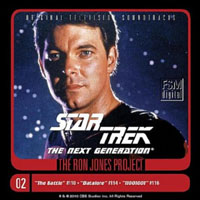11001001
A lot of fans seem to like this one and rank it above most other season 1 tales.
I'm not all that enamoured with it myself, regarding it as just another average
mediocre season 1 tale that sort of misses the mark.
|
There are a lot of good bits in it. Starbase 74 looks quite cool, having borrowed
model film elements from Star Trek III - The Search for Spock, which builds some
welcome consistency into the Trek universe. The mystery and action in the middle
of the piece builds nicely and contains many unusual ways of shooting the familiar
old sets.
Ron Jones also works hard at giving this story an exceptional, stand-out score.
Some of his strongest variations on Jerry Goldsmith's theme for the series are here,
underscoring the action sequences. The Bynars and their enhancements have some unique themes
and successful musical signatures, and the strong references to jazz bring a number of
appropriate source pieces into the mix as well. This is an even more enjoyable score to
listen to on CD, as the TV episode itself didn't always highlight the best bits when it
could have / should have, although many shots of opticals or empty corridors do indeed get their due.
|
|
|
But I think there are two main things bringing this story down. First is the aimless way
that this tale meanders through its opening 15 minutes or so. Characters are wandering off
doing whatever they please, while Riker bounces back and forth between them in a pretty bored state.
Even though the characters are miles better here than they were
in some of the earliest episodes,
they're not yet compelling with the actions given to them.
Compounding this is the all-too-specialist appeal of Riker's Holodeck fantasy-du-jour.
If either night clubs or jazz music are your thing, you might like what gets put on
screen here. If not, these characters are unlikely to make such sections appeal to you.
I think both Riker and Minuet appear to be pushing their interactions into a seductive mode
that hasn't arisen naturally or been earned, and their conversation appears to be blandly
following a formula rather than sparking out of anything remotely interesting. Whatever it is
that is supposedly making this holodeck simulation so much more realistic than those of
previous episodes certainly isn't obvious. Add on top
of this the very bizarre way that Picard butts his way into the fantasy, smiling and commenting
on everything - the illusion never really gets put together properly before being utterly
smashed and crushed underfoot. Perhaps it is telling that the story's jazz music is completely
separate from the Trekkian action score, as the two worlds never really merge cohesively.
All this adds to the first major problem - there's really no drive to the opening of the episode,
and it's not doing a very compelling job of exploring the concept of holodeck simulation.
That said, things really pick up in the second half, and Picard and Riker have some solid
challenges to work through all on their own, while the others comment on their mostly
helpless outside perspective.
However, the quality of this section kind of collapses under the story's second major problem
as the mystery is resolved and the truth revealed - the entire conflict
is now rendered extremely artificial. If the Bynars had thought to ask for help,
there wouldn't have been much of a story here, would there? Thus the aftermath of this
story leaves a hollow, empty aftertaste on what might otherwise have been a half-decent
action story.
A third problem also hides here waiting to be revealed if you actually take the time to
think through what the Bynars are trying to achieve... because the final sequences have not
given themselves enough time to breathe so that it can be achieved. Exactly when is all
the Bynars' precious data safely moved out of the way of the supernova's electromagnetic
pulse? Surely they want the Enterprise with its large mobile computer to move it all
away from their planet, wait for the pulse to pass, and THEN come back to restart their society.
Here, it seems they only just arrive at the Bynars' planet for the first time, gain
the precious data, and then push everything back down to the planet as fast as possible.
Isn't the point to gain the data before the pulse hits, then move it away to safety?
When did the pulse hit, and where was the data at that time? What was the big rush
to keep all scenes at the end running continuously, and not leave more space for this
transitional material to happen off camera?
In the end, it all feels much more limp than what Star Trek should be aspiring to. Another
typical season one outing, not quite hitting the mark.
|
|









 (regular)
(regular)



